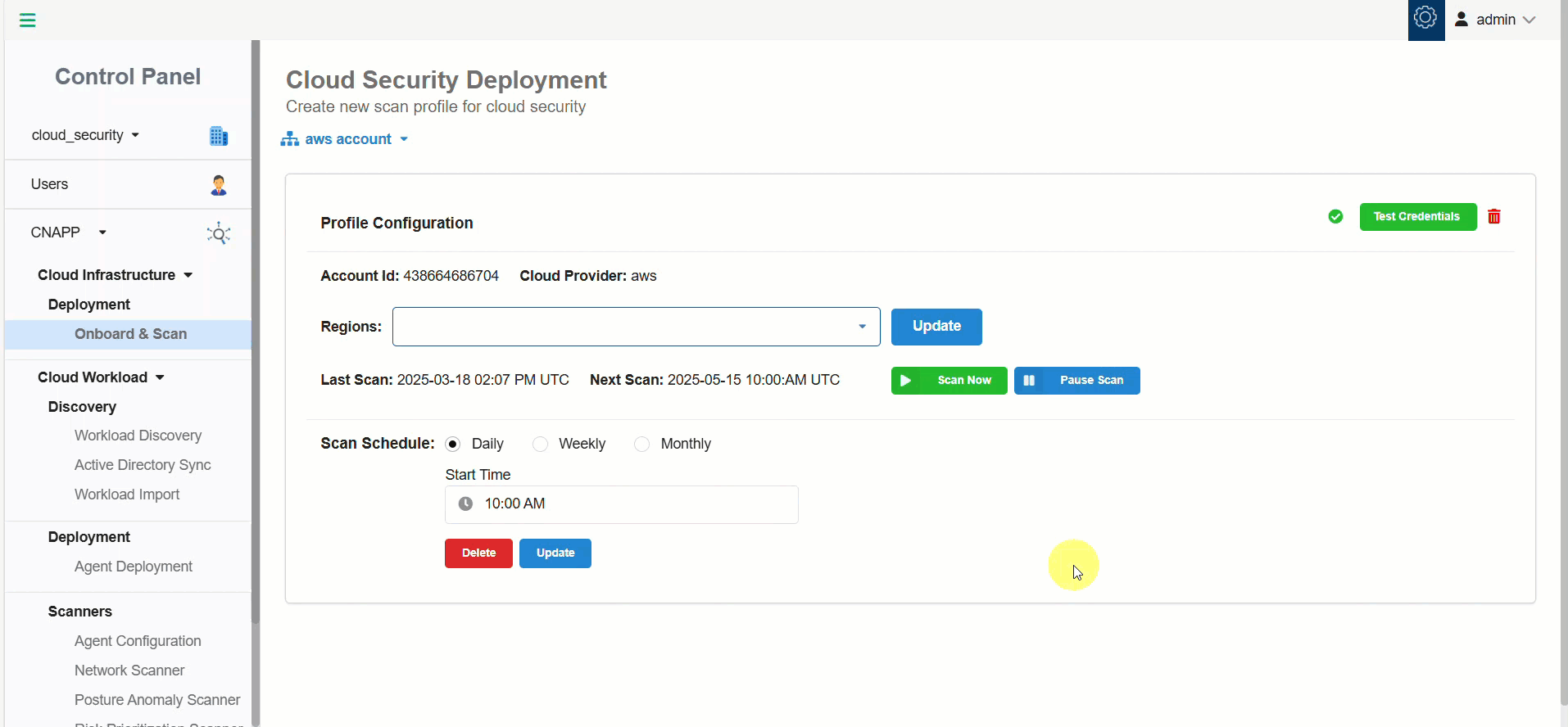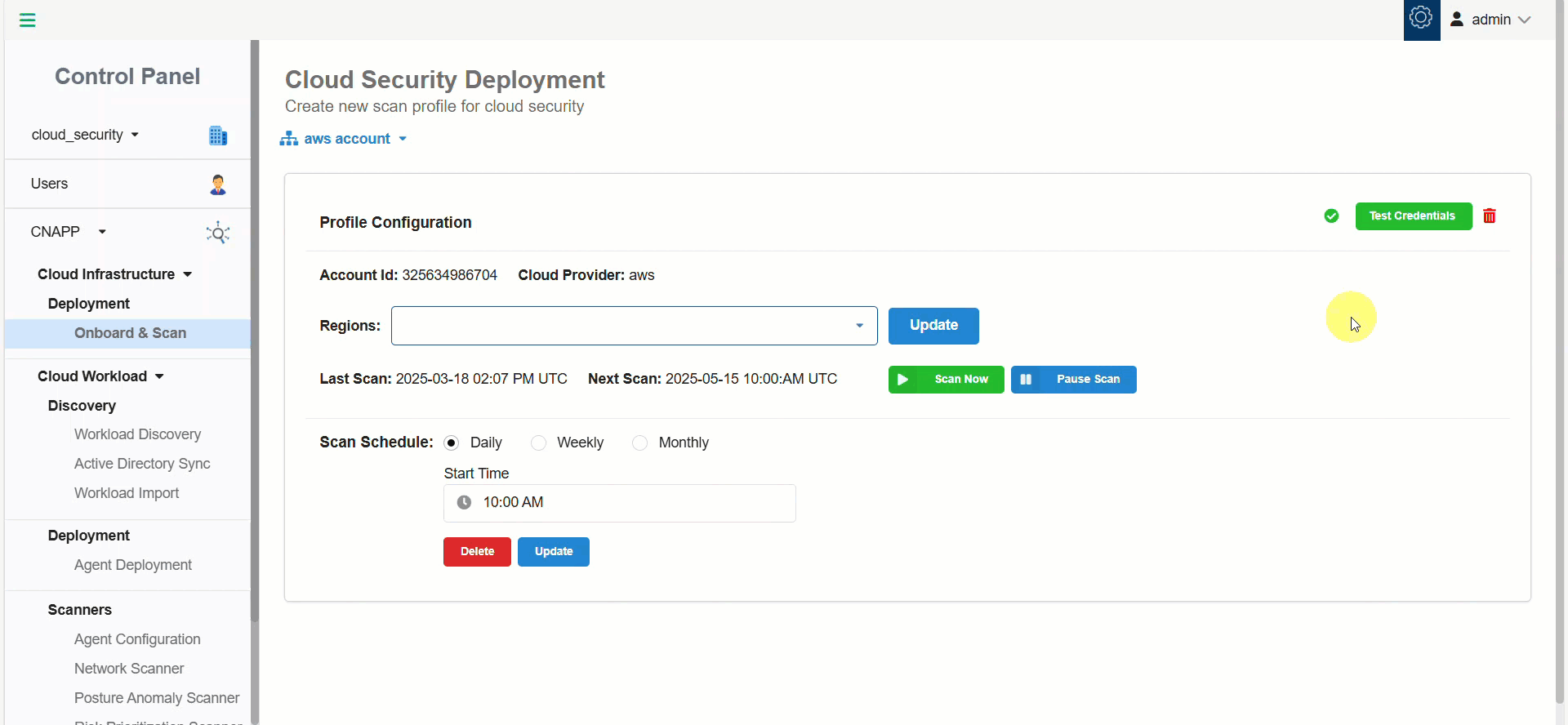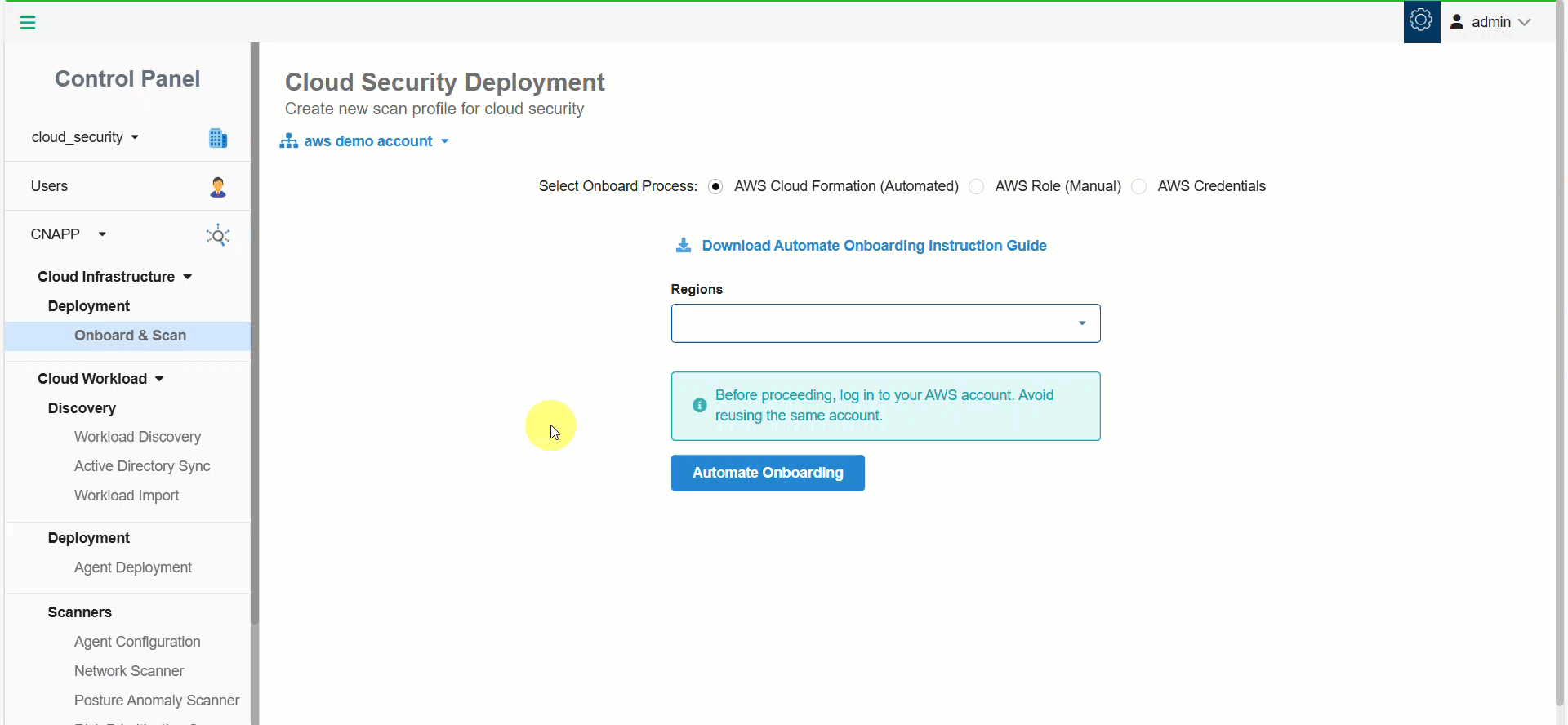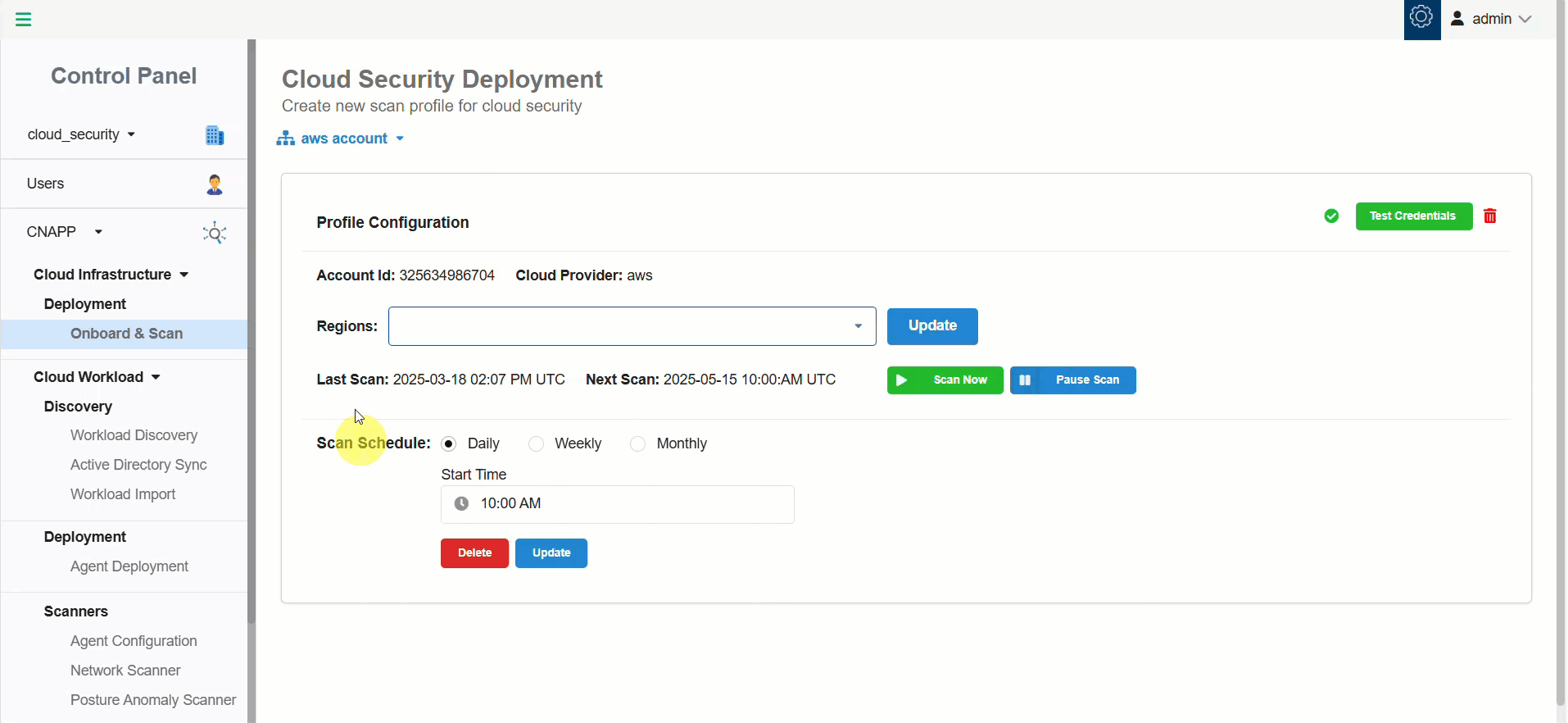Published Date: May 09, 2025
This release introduces several significant updates and new features aimed at elevating the user experience and addressing the evolving needs of modern cloud management. Key enhancements include: Pause and Resume Scans, Region-wise Onboarding and Scanning, Automated Patch Remediation, and improved AI capabilities.
Take a closer look at each of these for more details.
1. Single-Page Interaction to Complete Onboarding and Scanning
Users can now complete both onboarding and scanning tasks within a single interface in AWS or Azure.
Benefits of this integration:
- Streamlined Configuration: Users no longer need to navigate between different pages to complete these activities, making the process quicker and more efficient
- Improved User Experience: Users can complete the entire process without any hassles
Here’s how it works…
The system requires users to finish the onboarding process first, after which they are given the option to start scanning.
2. Pause and Resume Scans

Typically, server reboots, Windows updates, or any other activities can interrupt a scan. The Pause/Resume Scan functionality(available in AWS and Azure) addresses this issue by allowing users to pause the scan that’s already scheduled and then resume it from the point where it was paused.
When it comes to OnDemand Scan, observe the scan continues to remain in Pause mode. Users need to Resume the scan as needed.
What problem does the functionality solve?
With this feature, users no longer have to wait indefinitely or restart the scan from the beginning.
Here’s how it works…
With just the click of a button, pause all active scans or resume all paused scans.
3. Test Onboarding Credentials

In certain cases, the credentials used for onboarding cloud infrastructure into Saner Cloud might be created with an expiry date to meet regulatory requirements or inadvertently deleted by users. When this occurs, scans are likely to fail.
To address the issue, this release introduces the Test Credentials button.
Here’s how it works…
Clicking the Test Credentials button allows users to quickly verify if their onboarding credentials are still valid, ensuring smoother and uninterrupted operation.
4. Region Selection to Focus Scan on Specific Areas

As part of the onboarding process, users now have the facility to specify the AWS Region during scan configuration to manage resources effectively.
What’s the impact of region selection?
The regions chosen during onboarding significantly affect the scope of the scan and the resources being monitored. For instance, if a user selects only the “eu-west-2” region, then the scan focuses solely on those resources within that specific AWS region.
Here’s how it works…
Users can choose the desired regions from the drop-down list to include in the scan. However, if no region is selected, the system considers all the regions automatically for scanning.
5. Region Management for Cloud Profile Scanning

Region management enables targeted scanning, ensuring that the system only scans the areas where AWS cloud assets are actually located.
As a result…
You can ensure that all active regions are monitored, while inactive or deprecated ones are not left exposed to risks.
Here’s how it works…
Users are provided with the capability to dynamically update regions included in their cloud scan profiles.
- Add Region
Adds regions to the scanning scope. Newly added regions initiate an immediate scan. - Edit Region
This option allows you to modify the list of selected regions. On saving your changes:- New regions get automatically scanned
- Regions already removed no longer appears in the existing scan records
- Remove Region
Use this option to permanently remove regions from scanning. This action deletes any associated data from the existing scan records.
Click here to access Saner Cloud Deployment Guides
6. Saner Plasma AI Assistant
Users are now presented with the facility to refer back to previous conversations using the “Recent Searches” feature located on the left-hand side of the page. This allows you to view up to a hundred entries. However, once the limit is reached, the system automatically deletes older conversations and makes space for newer ones.
Saner Plasma AI Assistant maintains a logical connection in lengthy exchanges, expanding on context from earlier messages that feels more authentic and connected.
Click here to read more on AI assistant
7. Manage Report Views at Organization-level
Unlimited Custom Report Views
The system provides the facility to create unlimited custom report views to quickly access the data that matters most to users. You just need to select your preferred cloud provider — Multi-cloud, AWS, or Azure — and then search for and retrieve relevant reports directly within the Custom Reports section.
Send the Report over Email
Users have the facility to email the report to one or more recipients using the Email Reports option. If you’d want to send across to multiple recipients, then key in the email address separated by comma.
Rearrange Report Views in the Custom Reports Section
Users can easily drag and reposition any report view to the preferred location on the page.
Sync Dashboard Data to Report View
Refresh the data fetched from the infra dashboard and view it in the Custom Report with the click of a button.
Support for PDF format
In-addition to the grid view and spreadsheet format, users now have an option to download the report in PDF format for viewing
AI Assistant
The AI assistant is activated by clicking the green icon within any dashboard block. This action allows the assistant to understand the context of the displayed data and summarize crucial information in a tooltip format.
Additional Standard Features
Report view is extended to support other standard features such as: Expand or Collapse View, Export to Excel, Save Report, Backup Report etc.
Click here to read more on Managing Report Views at Organization Level
8. Automated Patch Remediation with Flexible Rule Management
Saner Cloud offers built-in rules that assist in fixing misconfigurations promptly after they are detected.
Here’s how it works…
Built-in Rules Detection
The system is pre-configured with rules to detect common misconfigurations and anomalies in your environment.
Automated Remediation Engine
Once a misconfiguration or anomaly is detected, the rule engine is triggered. It automatically manages the entire patching lifecycle: Scan → Detect → Remediate → Deploy.
Scheduling Flexibility
Patch deployments can be scheduled daily, weekly, or monthly without requiring manual oversight.
Customize Automation Configuration
Users have the ability to modify existing automation configuration, pause or resume automation as needed, and delete or recreate a new automation configuration from scratch to adapt to evolving requirements.
Click here to read on how to configure automation rule to remediate misconfigurations
9. Security Intelligence Feed for Saner CSRM Enhancement
In this release, the Security Intelligence Feed for Cloud Security Remediation Management(CSRM), covering CIEM and CPSM, includes additional rules to trigger corrective actions and automatically apply patches.
10. GUI Updates

This release introduces visual indicators on the Infrastructure Entitlement Management(CIEM) dashboard(AWS and Azure), allowing users to easily spot increases in resource counts within the Excessive Permission category.


